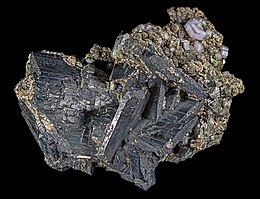Wolframite
| Wolframite | |
|---|---|
 | |
| General | |
| Category | Oxide minerals |
| Formula (repeating unit) | (Fe,Mn)WO4 |
| Crystal system | Monoclinic |
| Crystal class | Prismatic (2/m) (sameH-M symbol) |
| Space group | P2/c |
| Unit cell | a = 4.77Å,b = 5.73 Å c = 4.98 Å; β = 90.2°; Z = 2 |
| Identification | |
| Color | Grayish to brownish black |
| Crystal habit | Tabular to short prismatic crystals |
| Cleavage | Perfect {010} |
| Fracture | Uneven to rough |
| Mohs scalehardness | 4–4.5 |
| Luster | Submetallic to resinous |
| Streak | Reddish brown |
| Diaphaneity | Opaque |
| Specific gravity | 7–7.5 |
| Fusibility | 3–4 to magnetic globule |
| References | [1][2][3] |
Wolframiteis aniron,manganese,andtungstatemineralwith a chemical formula of(Fe,Mn)WO4that is the intermediate mineral betweenferberite(Fe2+rich) andhübnerite(Mn2+rich).[4]Along withscheelite,the wolframite series are the most importanttungstenore minerals. Wolframite is found inquartzveins andpegmatitesassociated withgraniticintrusives.[5]Associated minerals includecassiterite,scheelite,bismuth,quartz,pyrite,galena,sphalerite,andarsenopyrite.
This mineral was historically found inEuropeinBohemia,Saxony,and in theUKinDevonandCornwall.China reportedly has the world's largest supply of tungsten ore with about 60%.[6]Other producers areSpain,Canada,Portugal,Russia,Australia,Thailand,South Korea,Rwanda,Bolivia,theUnited States,and theDemocratic Republic of the Congo.[7]
Properties[edit]
The wolframite series is mainly formed through magmatic-hydrothermal processes associated with felsic magmas, namelyskarns,or through metamorphic processes. In the more common granitic deposits, wolframite minerals can be found in bothgreisenandveinsas its formation is tied to these two structures.[8]
Crystal structure[edit]

The wolframite series consists of two endmembers,ferberite(Fe2+end member),hübnerite(Mn2+end member), with Wolframite, (Fe,Mn)WO4itself being a solid solution between the two endmembers.[4]These two end members can be present in any proportion within wolframite, from 100% ferberite to 100% hübnerite. Wolframite Contains the following percentages of its components, 60.63% W+6,9.21% Fe+2,9.06% Mn+2,21.10% O−2.[9]Wolframite ore exhibits massive form with a dark grey to reddish black coloration.[5]Wolframite in its pure crystal form exhibits a monoclinic crystal system with a perfect cleavage of {010} and an iron black color. Wolframite in its crystalline form also displays lamellar and prismatic habit.[10]
Name[edit]
The name "wolframite" is derived from German "wolf rahm",the name given to tungsten byJohan Gottschalk Walleriusin 1747. This, in turn, derives from "Lupi spuma",the nameGeorg Agricolaused for the element in 1546, which translates into English as "wolf's froth" or "wolf's cream". The etymology is not entirely certain but seems to be a reference to the large amounts oftinconsumed by the mineral during its extraction, the phenomenon being likened to a wolf eating a sheep.[11]Wolfram is the basis for the chemical symbolWfor tungsten as achemical element.
World mine production and reserves[edit]
As of 2022, estimated world mine production was 84,000 metric tons of tungsten.[12]The foremost producer of Tungsten is China with an estimated 71,000 metric tons produced and as such world tungsten supply was dominated by China and Chinese exports. The next highest producers are Vietnam, Russia, Bolivia, and Rwanda with an estimated 4,800, 2,300, 1,400, and 1,100 respectively.[12]
As of 2022, the estimate world reserves of tungsten is 3,800,000 metric tons. Again China contains the greatest reserve at 1,800,000 metric tons of tungsten. The following countries have the next highest reserves: Russia, Vietnam, Spain, and Austria with an estimated reserve of 400,000, 100,000, 56,000, and 10,000 respectively.[12]
Use[edit]

Wolframite is highly valued as the main source of the metal tungsten, a strong and very dense material with a high melting temperature used forelectric filamentsandarmor-piercing ammunition,as well as hardtungsten carbidemachine tools. DuringWorld War II,wolframite mines were a strategic asset, due to its use in munitions and tools.[13]

Tungsten salts were used in the 19th century to dye cotton and to make stage costumes which were fire retardant. Additionally in the 19th century tungstensulfideswere sparingly used as lubrication for machining. Wolframite is also used to maketungstic acidwhich is used in the textile industry.[14]
A major modern day use of tungsten is as acatalystfor various chemical reactions. One such catalytic use of tungsten is as a hydrocracking catalyst which is used to improve the yield of organic components such as gasoline in hydrocarbon refinement as well as reducing harmful pollution and by products. Another catalytic use of tungsten is as a De-NOXcatalyst which is used in the treatment of nitrogen oxide emissions to convert harmful nitrogen oxides into inert N2gas.[14]
Another modern day use of tungsten is as a lubricant.Tungsten disulfide(WS2) is a lubricant with a dynamiccoefficient of frictionof ~0.03. Tungsten disulfide can be used at temperatures of 583 °C and 1316 °C in air and vacuum respectively. These characteristics allow this lubricant to operate in extreme conditions.[14]
Wolframite was considered to be aconflict mineraldue to the unethical mining practices observed in theDemocratic Republic of the Congo,during theCongo Wars.[15]
See also[edit]
References[edit]
- ^Barthelmy, Dave."Wolframite Mineral Data".webmineral.com.
- ^"Wolframite: Wolframite mineral information and data".www.mindat.org.
- ^Klein, Cornelis and Cornelius S. Hurlbut, Jr.,Manual of Mineralogy,Wiley, 20th ed. 1985, pp. 355-356ISBN0-471-80580-7
- ^abKing, R.J. (2005-03-01)."Minerals explained 41".Geology Today.21(1): 33–37.Bibcode:2005GeolT..21...33K.doi:10.1111/j.1365-2451.2005.00493.x.ISSN0266-6979.
- ^abHaldar, S. K. (2020).Introduction to mineralogy and petrology.Amsterdam: Elsevier.ISBN978-0-323-85136-7.OCLC1181840467.
- ^"USGS Circular 930–O: International Strategic Mineral Issues Summary Report—Tungsten".pubs.usgs.gov.Retrieved2023-02-10.
- ^"Clean them up".The Economist.19 August 2010.
- ^P., Kwak, T. A. (2014).W-Sn Skarn Deposits: and Related Metamorphic Skarns and Granitoids.Elsevier Science.ISBN978-0-444-59792-2.OCLC1044727909.
{{cite book}}:CS1 maint: multiple names: authors list (link) - ^PIRSSON, LOUIS V.; KNOPF, ADOLPH (November 1947)."Rocks and Rock Minerals".Soil Science.64(5): 434.Bibcode:1947SoilS..64..434P.doi:10.1097/00010694-194711000-00020.ISSN0038-075X.
- ^"Wolframite Mineral Data".webmineral.com.Retrieved2023-02-14.
- ^van der Krogt, Peter."Wolframium Wolfram Tungsten".Elementymology & Elements Multidict.Retrieved2010-03-11.
- ^abcShedd, Kim B. (January 2023)."Tungsten"(PDF).U.S. Geological Survey, Mineral Commodity Summaries.RetrievedMarch 22,2023.
- ^"Nazi Gold: Spain and Portugal".2011-08-19. Archived fromthe originalon 2011-08-19.Retrieved2017-11-11.
- ^abcChristian, J.; Singh Gaur, R.P.; Wolfe, T.; Trasorras, J. R. L. (June 1, 2011)."Tungsten Chemicals and their Applications"(PDF).International Tungsten Industry Association.pp. 1–12.RetrievedFebruary 19,2023.
- ^"Clean them up: Congo's conflict minerals".The Economist.Vol. 396, no. 8696. 21 August 2010. p. 41.Retrieved24 August2010.
